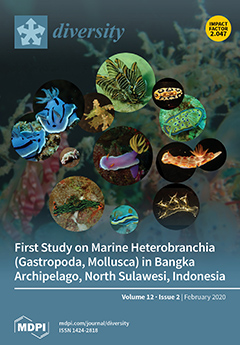Green fluorescence is a common phenomenon in marine invertebrates and is caused by green fluorescent proteins. Many hydrozoan species display fluorescence in their polyps and/or medusa stages, and in a few cases patterns of green fluorescence have been demonstrated to differ between closely
[...] Read more.
Green fluorescence is a common phenomenon in marine invertebrates and is caused by green fluorescent proteins. Many hydrozoan species display fluorescence in their polyps and/or medusa stages, and in a few cases patterns of green fluorescence have been demonstrated to differ between closely related species. Hydrozoans are often characterized by the presence of cryptic species, due to the paucity of available morphological diagnostic characters.
Zanclea species are not an exception, showing high genetic divergence compared to a uniform morphology. In this work, the presence of green fluorescence and the morpho-molecular diversity of six coral- and bryozoan-associated
Zanclea species from the Maldivian coral reefs were investigated. Specifically, the presence of green fluorescence in polyps and newly released medusae was explored, the general morphology, as well as the cnidome and the interaction with the hosts, were characterized, and the
16S rRNA region was sequenced and analyzed. Overall,
Zanclea species showed a similar morphology, with little differences in the general morphological features and in the cnidome. Three of the analyzed species did not show any fluorescence in both life stages. Three other
Zanclea species, including two coral-associated cryptic species, were distinguished by species-specific fluorescence patterns in the medusae. Altogether, the results confirmed the morphological similarity despite high genetic divergence in
Zanclea species and indicated that fluorescence patterns may be a promising tool in further discriminating closely related and cryptic species. Therefore, the assessment of fluorescence at a large scale in the whole Zancleidae family may be useful to shed light on the diversity of this enigmatic taxon.
Full article





